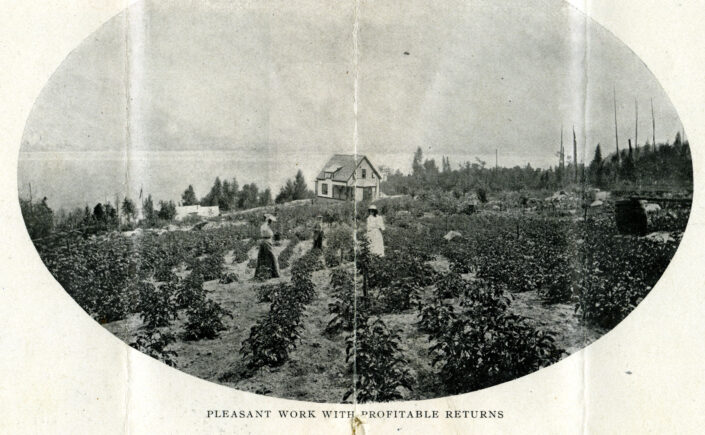After the completion of the Canadian Pacific Railway (CPR) in 1885, the Canadian Government and CPR set out on a campaign to entice Europeans to immigrate to British Columbia. Promotional pamphlets from the CPR boasting of the province’s large fertile valleys and wealth of natural resources flooded Europe, and around the turn of the twentieth-century, fruit ranching in BC took off. “In 1891, the total orchard area of [BC] was 6,500 acres. In 1906 it had increased to 49,000 acres.” 3
The majority of this expansion occurred in the Okanagan valley, which had relatively flat land and an ideal climate for fruit growing. As Okanagan fruit began to win prizes at exhibitions as far as Europe, the fruit-growing capabilities of BC began to gather attention, and pretty soon
“fruit ranching in British Columbia was considered an ideal colonial alternative for many disenchanted Englishmen who sought independence as well as prosperity.” 4
Though the Kootenay region, with its rocky forested shores and more extreme climate, had less than ideal orchard land when compared to the Okanagan, the area began to be promoted as a fruit-growing oasis.
A few fruit ranchers’ success was extrapolated as a projection for the entire region, and the reputation of the area was bolstered by that of the Okanagan. Land in the West Kootenays was even advertised as superior to that in the Okanagan, for the land was cheaper, and the steep hillsides were said to not require irrigation.
Real estate brokers and promoters sent glossy brochures and books glorifying the fruit ranching potential of the Kootenays to Europe. In one particularly embellished promotional pamphlet, The Glorious Kootenay, the area was said to have “the richest fruit land and farming land of the continent.” 6
Among the most prominent advocates of fruit ranching in the West Kootenays was J.T. Bealby who wrote two widely distributed books Fruit Ranching in British Columbia and How to Make an Orchard in British Columbia.
Another brochure, Kootenay Alone, claimed that “the only province of Canada that [could] produce apples of the fancy class [was] British Columbia.” And “that the only district even in British Columbia that [could] produce them [was] Kootenay.” 7
However, one book, written by Ernest Way Elkington, a man with no investment in the success of Kootenay orchards, cast a particularly honest outlook on the situation. In Canada, The Land of Hope, published in 1910, Elkington explained a revealing encounter on the nature of fruit ranches in the West Kootenays:
I asked him to tell me about the ranchers he had just left. ” Oh,” said he, ” they are rattling good fellows— stacks of money.”
“Did they make it ranching? ” I asked.
“No, they’re remittance men.”
“Happy? You bet you! Been out a couple of years.”
“Will they continue there, do you think? ” I asked. ” They may, if their money lasts,” he answered with a knowing smile.
“I soon found that the only men who were living lives at all endurable in the Kootenays were those who had money. No ranchers were making enough from their fruit to keep themselves in any sort of comfort. Even one of the officials of the Fruit Growers’ Association was working as an artisan in the winter, and most of the other ranchers were breaking their necks to get jobs to enable them to keep their larders filled and pay the losses on their fruit.” 8
While claims that one could grow rich from fruit farming in the West Kootenays were unrealistic, some of the publicity was not entirely unfounded. Fruit from the West Kootenays was often of exceptional quality. Apples produced by the likes of James Johnstone, one of the most successful fruit ranchers in the area, won prizes at the Royal Horticultural Society in London.
3. Fruit and Farm Lands Company Limited, The Wonderful Kootenay Fruit Lands 4. Welwood, British Columbia Historical News, 15 5. Lang, Lost Orchards, 2 6. The Glorious Kootenay 7. McDermid, Kootenay Alone 8. Elkingtion, Canada, The Land of Hope, 177-178
